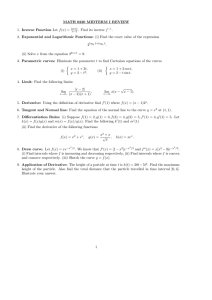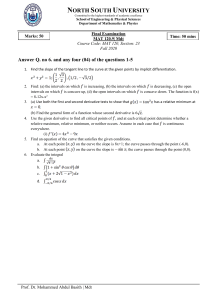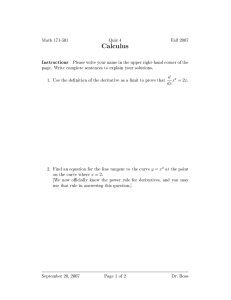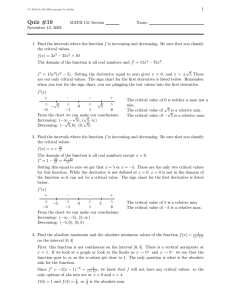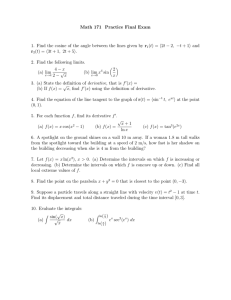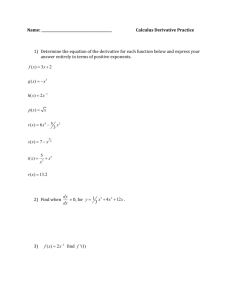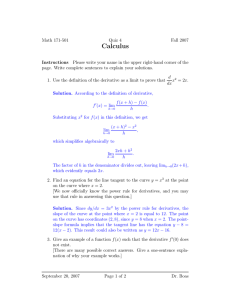AP Calculus 2003 Multiple Choice Test (non
advertisement
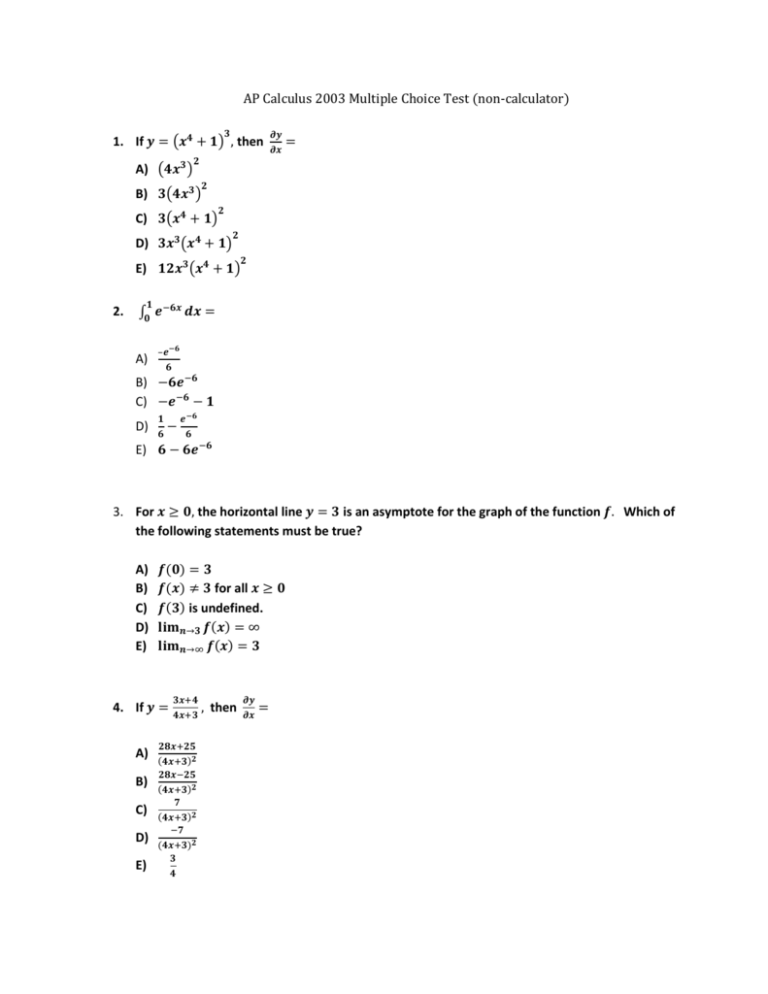
AP Calculus 2003 Multiple Choice Test (non-calculator) 1. If then A) B) C) D) E) 2. A) – B) C) D) E) 3. For the horizontal line is an asymptote for the graph of the function the following statements must be true? A) B) C) D) E) 4. If A) B) C) D) E) for all is undefined. then Which of 5. A) B) C) D) E) 6. A) B) C) D) E) 7. The graph of f’, the derivative of the function f, is shown above. Which of the following statements is true about f ? A) B) C) D) E) 8. A) B) C) D) E) 9. If , then is A) B) C) D) E) 10. The function f has the property that Which of the following could be the graph of f ? for all real values x. 11. Using the substitution is equivalent to A) B) C) D) E) 12. The rate of change of the volume, V, of water in a tank with respect to time, t, is directly proportional to the cube root of the volume. Which of the following is a differential equation that describes this relationship? A) B) C) D) E) 13. The graph of the function f is shown above. At which value(s) of x is f not differentiable? A) B) C) D) E) 14. If then A) B) C) D) E) 15. Let f be a function with derivative given by On which of the following intervals is f decreasing? A) B) C) only and only D) , E) only only 16. If the line tangent to the graph of the function f at the point (1,5) passes through the point (-3,-3) then f’(1) is A) B) C) D) E) -2 -5 1 2 5 17. Let f be the function given by The graph of f is concave down when A) B) C) D) E) x g’(x) -5 3 -4 4 -3 0 -2 -4 -1 -3 0 -2 1 -1 2 0 3 4 18. The derivative g’ of a function g is continuous and has exactly two zeros. Selected values of g’ are given in the table above. If the domain of g is the set of all real numbers, then g is decreasing on which of the following intervals? A) B) C) D) E) only only only 19. A curve has slope at each point on the curve. Which of the following is an equation for the curve if it passes through the point ? A) B) C) D) E) 20. Let f be the function given above. Which of the following statements about f is false? A) B) C) D) E) None I only II only III only I and II only Graph of f” 21. The second derivative of the function f is given by . The graph of f” is shown above. For what values of x does the graph of f have a point of inflection? A) B) C) D) E) 0, 4, and 6 only 2 and 5 only 4 only 5 only 6 only 22. The graph of f’, the derivative of f, is the line shown in the figure above. If then A) B) C) D) E) 0 3 4 7 11 23. A) B) C) D) E) 24. Let the function defined by 1. Which of the following is an equation of the line tangent to the graph of f at the point where ? A) B) C) D) E) 25. A particle moves along the x-axis so that at time its position is given by . At what time t is the particle at rest? A) B) only only C) only D) E) 26. What is the slope of the line normal to the curve at the point ? A) B) C) D) E) 27. Let f be the function defined by the value of ? . If what is A) B) C) D) E) 28. Let g be a twice-differentiable function with g’(x)<0 and g”(x)<0 for all real numbers x, such that g(4)=12 and g(5)=9. Of the following which is a possible value of g(6) ? A) B) C) D) E) 15 12 9 6 3 Solutions 1. 2. 3. 4. 5. 6. 7. 8. 9. 10. 11. 12. 13. 14. 15. 16. 17. 18. 19. 20. 21. 22. 23. 24. 25. 26. 27. 28. E D E D B C D B C C C E E E D D C A C D C D E B E C B E


